On most days, more than two dozen men — many recent arrivals from West African countries — sit across the street from the Wegmans on Astor Place in the East Village, refreshing their Instacart app until a compelling enough order comes in.
“It has to be good for you,” explained 29-year-old Diallo in French. “It depends. The number of items, the distance.”
His phone dinged: two orders had come in and were up for grabs. One order, to be delivered at an apartment almost 2.5 miles away, would pay him about $17 to carry 35 items. The other was 3.2 miles away and would only pay him a bit over $10. He passed on both.
Delivery work in New York City has faced a reckoning in recent years. After the pandemic, the essential workers toiling for restaurant delivery apps organized and won a minimum wage in 2021. But since then, grocery delivery services like Instacart have grown, but their workers are not included in the minimum wage legislation, leaving thousands of recently arrived immigrants, mostly Africans, unprotected and exploited.
In the three hours since Diallo started working “his shift” at 8:30 a.m., he’d gone on two runs on his rented e-bike, each roughly three miles away. Each run paid him about $15, out. Diallo, who declined to share his last name because of his immigration status, arrived in New York City about 10 months ago from Guinea. He began working through Instacart in September when he finally received his work permit.
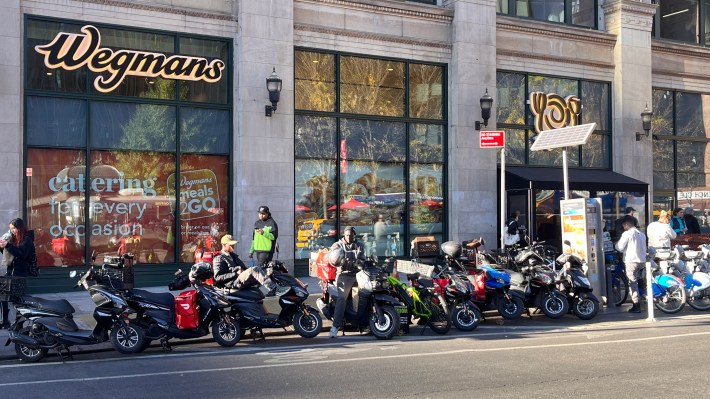
Advocates who work with immigrants say the recently arrived asylum seekers from Africa have almost no access to workforce training, making this the only option.
"The issue is that, for Black migrants, there is no workforce training for us. [The city] did not see us as valuable enough to do that," said Adama Bah, the founder and executive director of Afrikana. "The community has to resort to whatever they can do to survive and make ends meet. Delivery bikes are the fastest and easiest way right now, but the reality is there is no other workforce training for them."
The Instacart loophole
Instacart started operating in New York City in 2014, and is now the largest grocery delivery company in North America, according to its most recent quarterly earnings report. Initially Instacart workers used cars to pick up and drop off orders, and many still do. At Wegmans in the Brooklyn Navy Yard, the large parking lot has 14 car spots dedicated to Instacart pickup.
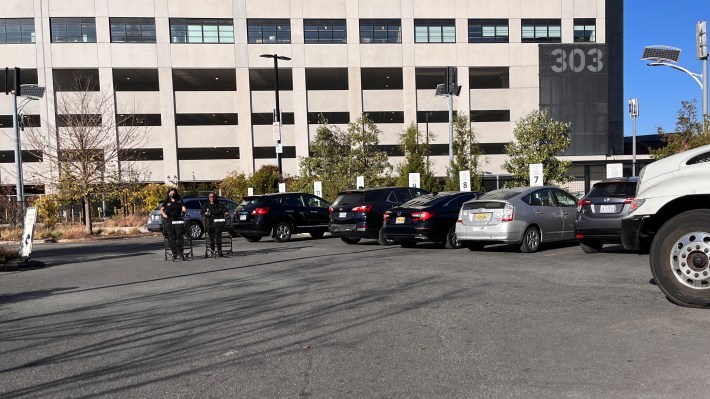
Instacart workers used to make deliveries by car, but in 2022, the company allowed e-bike or moped riders to join the workforce, which led to a rise of new immigrants signing up. But no matter how the delivery is made, the company operates within the loophole in the minimum wage law, meaning that the immigrants waiting for orders outside of Wegmans and other stores are not seeing the same benefits as their deliverista counterparts who make $19.96 an hour when they are logged in or traveling back from a delivery.
And that makes no sense, said experts.
"It's illogical that on the same day on the same bike, a worker could deliver a slice of pizza from Wegmans and they don't have to pay him minimum wage, but if he delivered a slice of pizza from a pizza shop, they do," said Baruch Herzfeld, who runs Popwheels, an e-bike charging infrastructure company that works with delivery workers. "These guys are basically employees, they spend all day outside of the store and both Wegmans and Instacart should be paying them a fair wage and providing them with safe equipment."
The company said the two-wheeled orders would be "limited to shorter distances and fewer item counts, to make sure they can be easily fulfilled without a car." But workers at Wegmans told Streetsblog they often travel as far as the Bronx and have to fit 4-5 bags of groceries on their bikes.
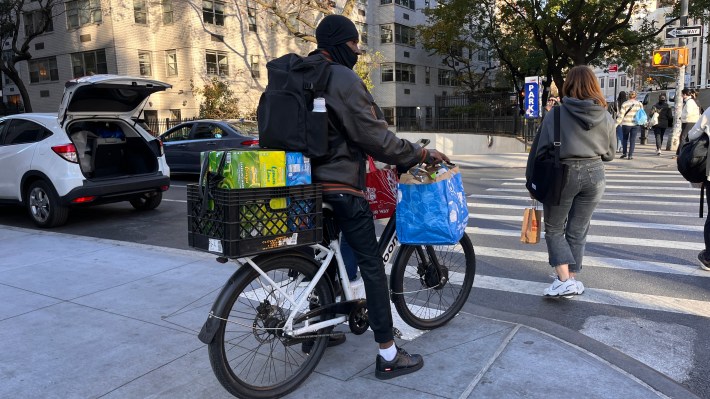
Instacart has also become a second option for workers who are unable to make a living on the restaurant apps because many tech companies have locked out workers since the minimum pay standard went into effect.
“Instacart, there’s not the same pressure,” said 36-year-old Lassina, who is from the Ivory Coast and has a Green Card. “There’s no schedule. You come whenever you want, at whatever time,” he added, saying “schedule” in English. “You’re free, you know?”
The moment UberEats and Doordash enacted the “schedule,” Lassina said, he quit the food delivery apps and started working for Instacart.
His phone pings, alerting him to a two-stop delivery for $57: the first stop is somewhere in the East 70s, and the second farther into the East 90s.
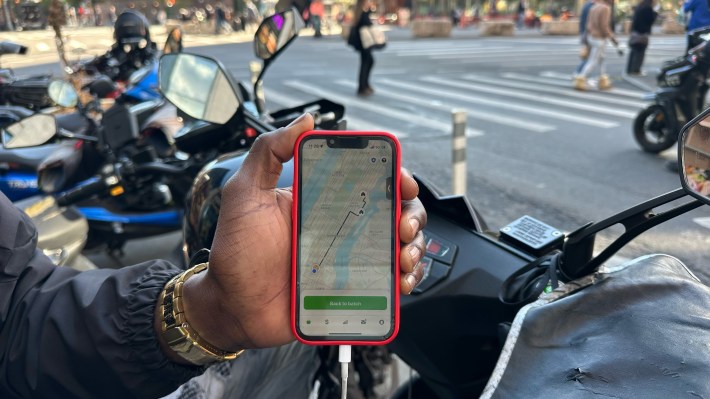
Since the pay standard passed for deliveristas, wages have gone up dramatically ... for those who are working. Others have been forced to leave the industry because the companies now limit access to the system. This alienates some workers and makes it hard for new arrivals to get a foothold in the industry. Many have switched to Instacart because of this.
Experts who study the minimum pay law say that the companies created a false sense of work availability pre- minimum wage. They allowed as many workers as possible to be on the apps, but there wasn't enough demand to pay every worker enough.
"It’s inevitable [that workers are now using Instacart] because the companies wanted to have it both ways. They wanted to have as many workers on their app as possible, and they wanted to pay them whatever they want," said James Parrott, the director of economic and fiscal policies at the Center for New York City Affairs at The New School, who consulted with the city on the landmark minimum pay law.
The city's promises
New Yorkers are not slowing down in their desire to have everything — and anything — delivered to their front door, and groceries are a booming business. According to Instacart’s quarterly earnings report, more than 25 million people have used their service between August 2023 and August of this year and the company's profits have grown by 10 percent in the same period.
The Adams administration has promised to create a new city agency to regulate the growing delivery industry further. The Department of Sustainable Delivery was announced in January, but it is still unclear exactly how the city will enact regulations. And it is unclear if it will close the Instacart loophole.
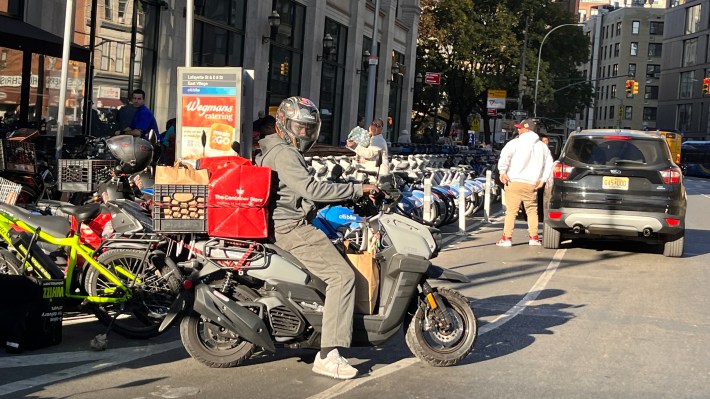
"We have continued to gather feedback and input from delivery workers and companies, advocacy groups, and business improvement districts seeing the most commercial micromobility activity. The Adams administration is also working closely with the City Council to draft comprehensive legislative solutions that would create a safer environment for workers and pedestrians alike," a City Hall spokesperson told Streetsblog.
The city has been aware of workers like Diallo who are falling through the minimum wage law's cracks. In the mayor's "Blueprint for Economic Recovery," announced in 2022, the city estimated that 17,000 workers were not being covered by the minimum wage, and this was before Instacart expanded its fleet to include e-bikes and mopeds, so that number is now likely much higher.
Earlier this month, Comptroller Brad Lander released his own delivery focused report. The report, Street Safety in the Era of Micromobility, suggests the city create a “city-administered licensing program” to regulate app-companies, but does not mention grocery delivery.
A representative from the Comptroller's office told Streetsblog that the proposed licensing program is a framework that can and should be extended to grocery delivery.
Few options
The workers waiting at the East Village Wegmans are particularly vulnerable. Most have been in the United States for less than a year and have gone through the asylum-seeker process. The migrants, many of whom have escaped horror to come to New York, are thrust into bureaucratic limbo where they can’t even apply for a work permit until their applications have been pending for at least 150 days.
African immigrants now account for 16 percent of the 64,000 recent arrivals living in New York City shelters, up from 13 percent last fall, Molly Schaeffer, the director of the city's Office of Asylum Seeker Operations, testified at a Council hearing in April.
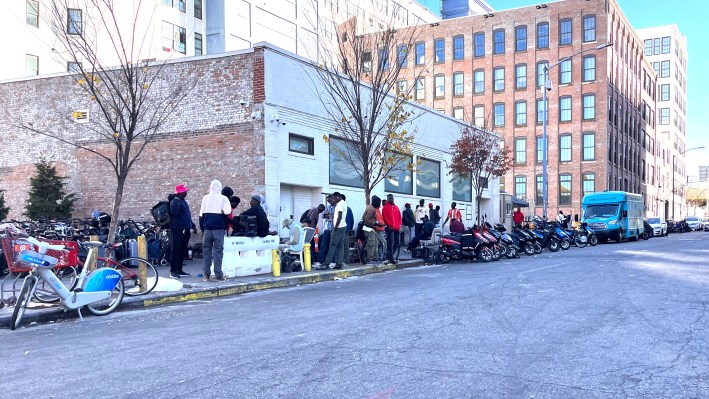
For many, entering the world of delivery work was the first step after finally earning their permits, with the other men sitting beside Diallo at Wegmans acquiring them over the past few months. They had looked for other jobs that were more stable, but language was an oft-repeated barrier.
"The reason why you see them all on bikes, is because [the city] refuses to give them workforce training," said Bah. "Most of these men come here with skills, but they don't speak the language."
For Bah, her advocacy work with African migrants has thrust her into the world of delivery work. She said that the vast majority of migrants she speaks to start working for Instacart because there are no other options. She'd like to see collaboration across worker groups so that her community can organize for their own protections.
"Someone needs to sit down with me and my team and tell us how we can advocate for delivery workers in our community. I don’t want to reinvent the wheel, because these are people’s livelihoods that we’re talking about," said Bah.
Wegmans did not respond to request for comment. Instacart declined to provide numbers for how many workers are employed in this fashion.






